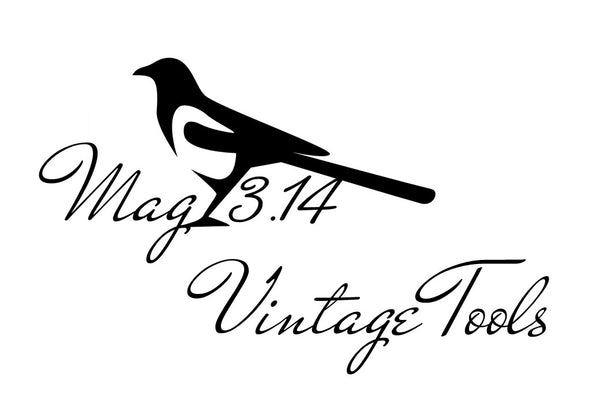Collection: Copperhead Soldering Irons
Introduction
Before the widespread adoption of electric soldering irons, craftsmen and metalworkers relied heavily on copper head soldering irons to join metals. These tools, often heated over open flames, provided the heat needed to melt solder and create strong, lasting bonds. Over the years, many tool makers became renowned for their quality craftsmanship, producing soldering irons that became indispensable to industries such as plumbing, roofing, electronics, and jewelry making. This article explores the history of these vintage tools, highlights notable tool makers, and examines the variety of applications they were used for.
The Anatomy of a Copper Head Soldering Iron
A typical vintage copper head soldering iron consists of three primary components:
-
Copper Head – The tip, made from solid copper due to its excellent heat retention and conductivity, allowed for consistent soldering. The heads were often chisel-shaped, pointed, or flat, depending on the application.
-
Iron Shank – The copper head was attached to a sturdy iron shank that extended into a handle. The length of the shank provided distance between the heated tip and the user’s hand, preventing burns.
-
Wooden Handle – Handles were typically made of hardwood, designed for comfort and insulation against heat. These handles allowed artisans to maneuver the iron safely and accurately.
Notable Vintage Tool Makers
1. Edward Preston & Sons (UK)
One of the most recognized names in vintage hand tools, Edward Preston & Sons produced high-quality soldering irons during the late 19th and early 20th centuries. Known for their attention to detail and durable designs, Preston’s soldering irons were favored by metalworkers and plumbers alike.
-
Specialty: Preston produced a range of copper head soldering irons with varying tip shapes, making them suitable for fine detail work or larger joints.
-
Distinguishing Feature: The hallmark stamped on the handle or shank, often reading "E. Preston & Sons."
2. PS & W Co. (Peck, Stow & Wilcox, USA)
Based in Southington, Connecticut, PS & W Co. was a prominent American manufacturer of soldering irons in the late 19th and early 20th centuries. Their soldering irons were considered reliable and well-balanced, making them popular among American tradesmen.
-
Specialty: Produced heavy-duty copper head irons that retained heat longer, ideal for plumbing and roofing applications.
-
Distinguishing Feature: The company’s iconic “PS&W” mark on the metal shank.
3. Geo. Barnsley & Sons Ltd. (UK)
Another notable British manufacturer, George Barnsley & Sons, was widely known for producing high-quality tools, including soldering irons. Their irons were commonly used by leatherworkers, tinsmiths, and jewelers.
-
Specialty: Smaller, precision soldering irons that catered to fine work, such as detailed metal crafts.
-
Distinguishing Feature: Barnsley’s mark often included the name and origin stamped on the shank.
4. H. Boker & Co. (Germany/USA)
A German manufacturer that expanded operations to the United States, H. Boker & Co. created a variety of soldering irons that gained a reputation for quality and longevity.
-
Specialty: Produced irons for both industrial and delicate applications, including tinning and precision soldering.
-
Distinguishing Feature: Irons were typically marked with the company’s tree logo, a symbol of quality and craftsmanship.
Applications and Work Types
1. Plumbing and Roofing
Heavy-duty copper head soldering irons were essential tools for plumbers and roofers. These professionals used large, wedge-shaped irons to solder lead pipes, seams, and roofing panels. Plumbers often relied on irons that could retain heat long enough to complete large joints without re-heating.
-
Common Iron Types: 1 lb to 5 lb copper heads with broad, chisel tips.
-
Notable Maker Preference: PS & W Co. was favored for these larger soldering irons.
2. Sheet Metal Work and Tinsmithing
Tinsmiths used smaller, more maneuverable soldering irons to assemble and repair sheet metal goods. Precision work, such as creating tin boxes or decorative items, required irons with fine-pointed tips to ensure clean joints and minimal excess solder.
-
Common Iron Types: ½ lb to 2 lb irons with pointed or small chisel tips.
-
Notable Maker Preference: Geo. Barnsley & Sons supplied many tinsmiths with high-quality irons.
3. Jewelry Making and Fine Metalwork
For intricate work in jewelry and metal artistry, smaller copper head irons were used. Jewelers required fine control over the temperature and solder flow to create clean, precise joints.
-
Common Iron Types: Small irons with pointed or conical tips, often under 1 lb.
-
Notable Maker Preference: H. Boker & Co. offered finely crafted soldering irons ideal for this delicate work.
4. Electrical and Early Electronics
Before modern electric soldering irons, early electronics work required copper head soldering irons with small, precise tips to join electrical wires and components. These irons were often heated in open flames or with small gas burners.
-
Common Iron Types: Lightweight irons with narrow tips for tight spots.
-
Notable Maker Preference: Edward Preston & Sons produced models suitable for this fine work.
-
Antique Interesting Primitive Copper Head Hammer or Iron
Regular price £19.99 GBPRegular priceUnit price / per -
 Sold out
Sold out8oz Copper Head Soldering Iron
Regular price £14.99 GBPRegular priceUnit price / per -
90 Degree Vintage Copper Head Soldering Iron
Regular price £12.99 GBPRegular priceUnit price / per -
Moore & Wright No 6 Copper Head Soldering / Tinning Iron
Regular price £14.99 GBPRegular priceUnit price / per




